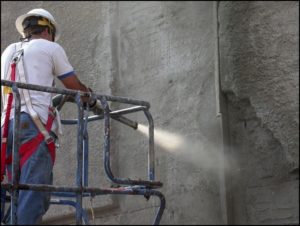Q: What is shotcrete and when would I use it?
A: Shotcrete is concrete and refers to the method of placing it using a high-velocity spray onto a receiving surface. The American Concrete Institute (ACI) defines shotcrete as concrete placed by a high velocity pneumatic projection from a nozzle.
It has all kinds of applications:
- Ground support
- Repair and restoration
- Structural linings
- Pools
- Architectural structures and landscape, like zooscapes, skateboard parks, retaining walls, or bridge art
- Tanks and domes
- Taxidermy, one of the earliest uses
Shotcrete, which is sprayed vertically or overhead, can be applied over masonry, concrete, soil, and a multitude of other substrates. Once you’ve placed it, you can easily finish or carve it. The concrete lions on the Lions Gate bridge in Vancouver, Canada, were formed with shotcrete.
Q: How is shotcrete processed so it can be placed?

A: There’s a dry-mix process and a wet-mix process. With dry, you take a dry pre-blended shotcrete bag mix, empty it into a hopper, and convey it by compressed air through a hose to the nozzle where water is introduced. Mixing of the dry product with water takes place in the nozzle and on the receiving surface during application.
With the wet-mix process, you take a concrete mix with water in it or you use a dry pre-blended product that you mix with water and place it in the pump that delivers the concrete mixture though the hose to the nozzle, where you add compressed air.
Q: Can I use a plaster gun for shotcrete?
A. No, shotcrete is applied with high velocity, and a plaster gun sprays at a low velocity. By definition, shotcrete has to have a high velocity component.
Q: Who is trained to work with shotcrete and what are the qualifications?
A: The person who is an expert at placing shotcrete is called a nozzleman, and there is an ACI certification program for nozzlemen.
To take the course and get certified, a nozzleman has to have had 500 verifiable hours of experience as a nozzleman. There is also a Nozzleman-in-Training program if one has between 25 and 500 hours of experience as a nozzleman. The nozzleman-in-training can upgrade to a full nozzleman certification once he/she reaches 500 hours. It’s possible to get certified for any combination of vertical and/or overhead for dry mix and/or wet mix.
The nozzleman certification involves a day-long educational session where a nozzleman takes a written exam at the end of the session and a practical exam where the nozzleman shoots test panels with specific rebar configurations to demonstrate their knowledge and skill. Once test panels are shot, they are cored and judged on the ability of the nozzleman to properly place shotcrete and how well the nozzleman encapsulated the rebar.
I am an ACI shotcrete examiner and educator.
Q. What happens when a nozzleman is inexperienced?
A. An inexperienced nozzleman will use improper techniques and can significantly reduce the quality of the placement.
Also, if the nozzleman doesn’t use the proper concrete mix consistency or velocity, you can get sloughing and fallouts as well as voids and sand lenses.
Finally, the nozzleman needs to shoot at a 90-degree angle to the receiving surface or he will generate too much overspray and rebound. Excessive rebound and overspray results in unconsolidated material that has very little paste. You’ll end up with much weaker, less durable concrete if you don’t remove this material.
Q: Do you have to cure the concrete?
Yes, because shotcrete is concrete, after all, and to promote the chemical reactions necessary to gain strength, you need to have water available. If you don’t cure it, you will have lower than anticipated strengths.
Q: How do you cure the concrete?
A: You can use a membrane-forming curing compound, but if you’re going to be placing more shotcrete, you have to remove the membrane because it is a bond breaker. Or you can use plastic, web burlap, a burlene curing blanket, or fogging/misting to keep moisture in the concrete.
Depending on conditions, you’ll want to moist cure it for at least seven days.
Q: What’s the advantage of using shotcrete?
A: With shotcrete, you don’t need as much formwork as you do for cast-in-place concrete. Usually, the receiving surface is the form, like a culvert, and you can easily smooth and shape it. Cast-in-place concrete requires putting up a lot of forms and placing concrete into them. It takes a lot of time and materials. Shotcrete can be more economical than conventional concrete placements.
Also, shotcrete produces a denser concrete due to high impact velocity on the receiving surface.
